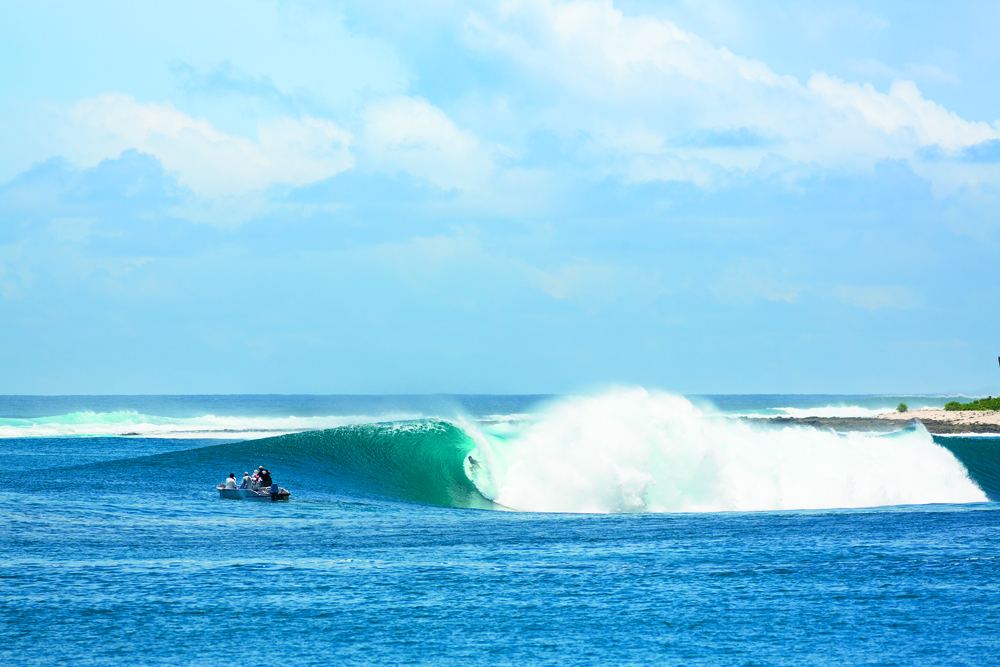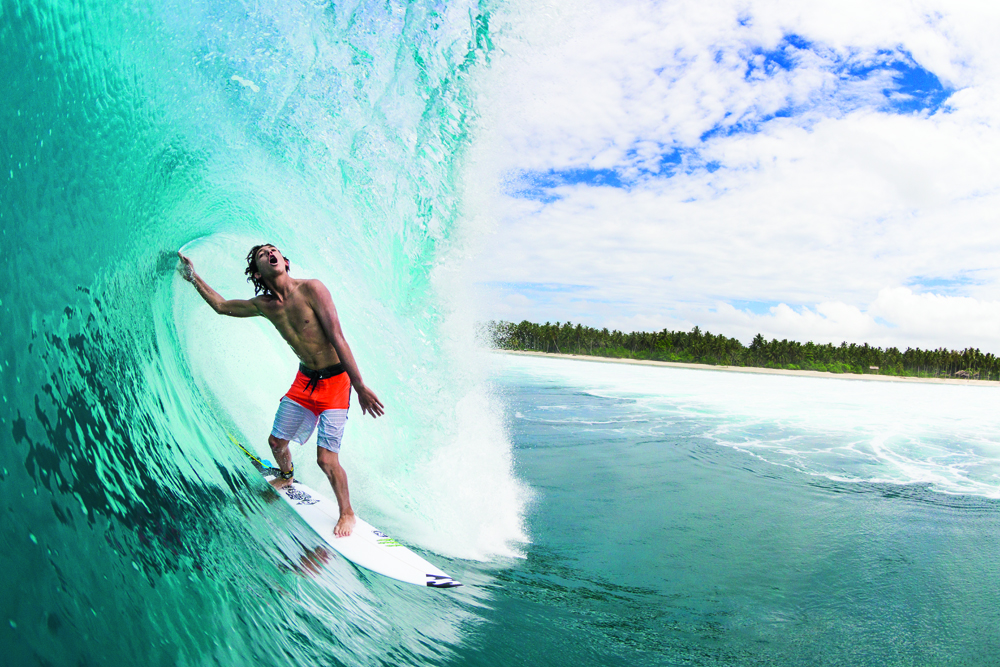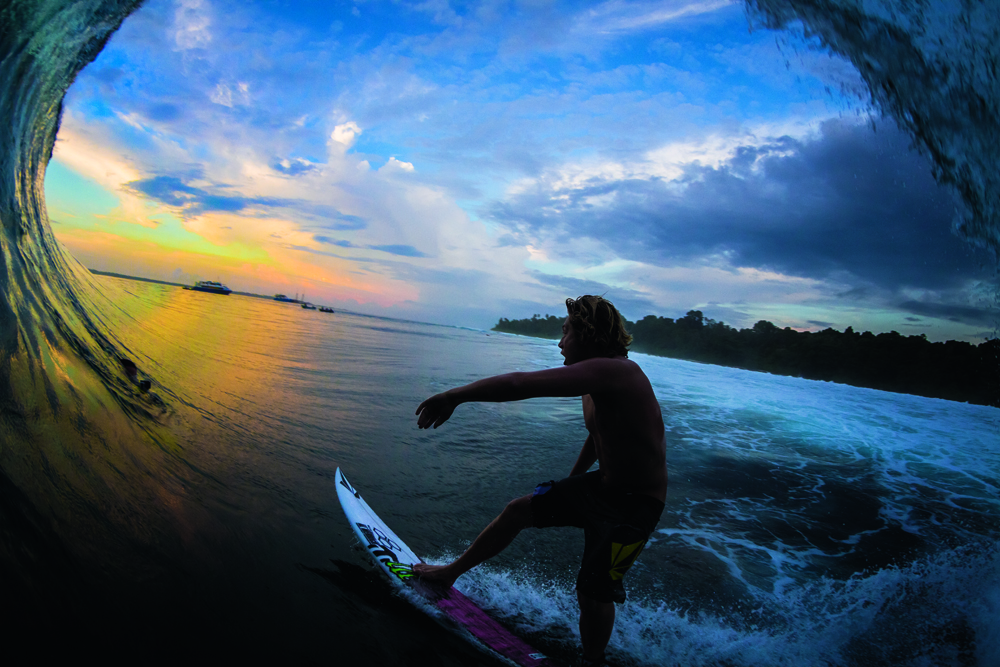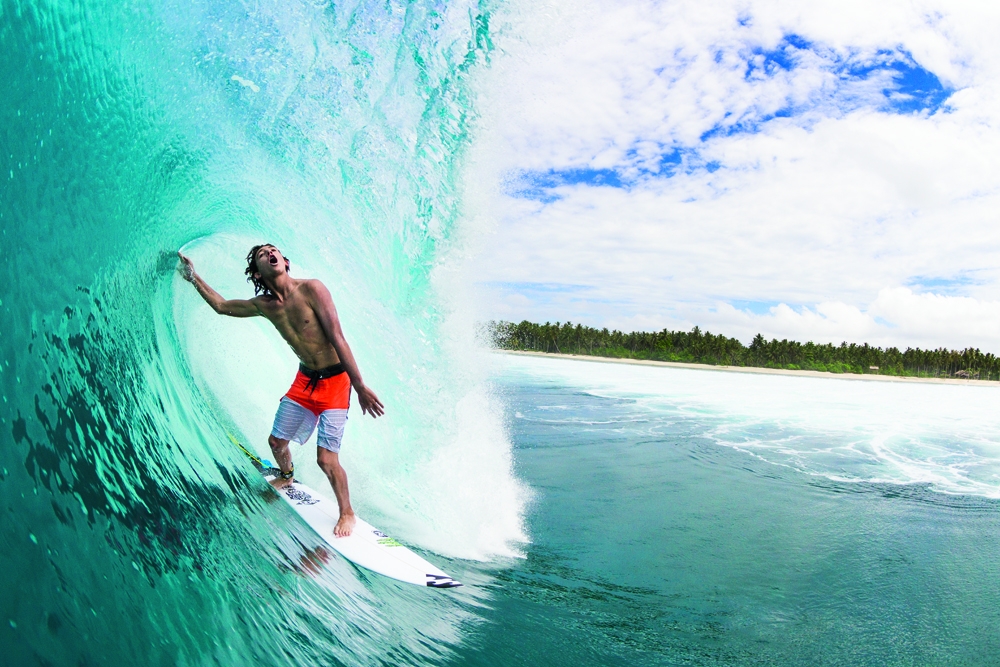When we saw the latest installment of Red Bull’s Ripple Effect delve into the discovery of Lance’s Right, we couldn’t help but publish this story. Y’see, Tim Baker is one of the creators behind The Ripple Effect series, and has also been a good pal of Surfing Life’s for as far back as we can remember – over the years he’s given us a wealth of knowledge on this particular wave.
This article was published in our Travel Bible issue, SL 308 – In the latest issue, The Indonesia Issue, we have another special feature on Lance and his wave. If you’d like to read that, then click here.
 Dillon Perillo getting pretty barrellioed. Photo: Ryan Craig
Dillon Perillo getting pretty barrellioed. Photo: Ryan Craig
Words Tim Baker
It’s May, 2003. I’m walking through the village of Katiet, on the island of Sipora, in the Mentawais, with the man who discovered the now world-famous wave that fronts the village – Lance’s Rights. The obligatory gaggle of excited kids trail us, offering high fives. We are looking for Pak Hosen, the local fellow who took Lance in, fed him and housed him when he turned up on these shores unannounced back in 1991. Twelve years later, this is the first time Lance has been back to his great wave discovery, which has since become a household name throughout the surfing world.
Lance knocks on the door of a low, besser-brick cottage as I stand back, video camera at the ready to record the historic moment. A woman comes to the door, regards the Western white man curiously as he extends a hand, beaming. “Lance,” he says simply. A wave of recognition washes over the woman’s features as she repeats, “Lance”.
She turns to call out to the rest of the household, louder now, “LANCE”.
Her husband, Pak Hosen, comes to the door in shorts and singlet, eyes sparkling, arms outstretched, shaking his head slightly as he repeats the name incredulously. “Lance. Lance.” The two men embrace. It’s an emotional sequel to perhaps the greatest surf discovery of the modern age.
In most parts of the world this would be considered a pretty humble abode, but here in Katiet it’s one of the grandest homes in the village. When Lance first came here, Hosen and his family lived in a simple wooden shack on the beach, now half buried in sand. They lit a small fire inside at night to keep the malarial mosquitoes at bay. Twelve years on they have a thriving homestay business. Hosen gives us the tour, proudly shows off the diesel generator he now owns, the extra rooms he has added to house the visiting surfers who now flock here. The kitchen’s piled high with cartons of eggs and other provisions to keep hungry surfers fed. A bed and three meals sets you back around $20 a day, a price that has barely risen in the 10 years since, even though high-end surf resorts now proliferate throughout the islands.
The story of how Lance first came to discover the wave that would carry his name sounds as implausible as a schoolboy surf fantasy dreamt up while doodling waves during double maths, a true Boys Own Surf Adventure. Lance had been plying the Yamba-to-Lord Howe Island run in an old cargo ship for years off the New South Wales north coast, delivering supplies to the tiny island community and enjoying the odd sly surf during lay-overs. When he lost his job and his girlfriend in quick succession, he thought he’d go to Singapore, look for a boat to buy and duck across to Nias, off the west coast of Sumatra, and try and score some surf. “I was really stressed out, so I thought, I’m out of here,” he recalls.
 Griffin Colapinto proudly displaying the ecstatic throes of pubescent tube-riding. Photo: Ryan Craig
Griffin Colapinto proudly displaying the ecstatic throes of pubescent tube-riding. Photo: Ryan Craig
Lance had met legendary surf explorer Peter Troy on a trip to Lord Howe and had been spellbound by his stories of discovering the famous right-hander at Nias back in the early ’70s. “That inspired me a bit and I thought I might see if I could find my own Nias,” he says. He’d got hold of marine charts of the area and started looking at a promising island chain to the south of Nias, called the Mentawais. Although Nias had been surfed for 20 years by this stage, somehow the Mentawais had remained virtually unmolested by surfers.
Lance flew to Sibolga in Western Sumatra and, after a typically hair-raising overnight bus ride, arrived in the bustling port town of Padang. “Almost as soon as I got off the bus in Padang this truckload of soldiers pulled up and insisted that I jump in with them,” says Lance. “I didn’t know what they wanted, but they were very insistent, so I hopped in. I thought, Uh-oh, what’s going on here?” As it turned out, Lance had arrived during Padang Tourism Week, and a gala launch had been marred somewhat by the complete absence of tourists, so the soldiers had been ordered to drive around until they found some. “They drove me down to the beach and there was this huge reception, with dancers and politicians and dignitaries all gathered around under these big banners,” he says. “I had to sit there, in the front row, through all these speeches and dances, as the honorary tourist.”
After this auspicious start, Lance spent the next two days walking around town, trying to find a fishing boat to take him out to the islands around 100 ks off the mainland. He befriended a local rock star named Henry, and together they hit the town, where they were mobbed by screaming girls wherever they went. Henry introduced him to an Iranian doctor based in Padang, Dr Manoo, who had been conducting medical clinics in the Mentawai Islands for years as a one-man humanitarian mission. For $50 Lance was able to hitch a ride on Dr Manoo’s next flight out to the islands in a light plane. Equipped with one board, a backpack, a bag of rice and a water bottle, Lance found himself deposited on a grassy airstrip on the sheltered, waveless side of the island of Sipora. “Dr Manoo went off into the village, and I was just sort of left alone,” says Lance. “I started walking along the beach. This old guy came paddling along in a canoe and pulled into the beach. I couldn’t speak Indonesian and he couldn’t speak English, but we communicated by sign language, and I offered him some money to give me a ride.”
The old man transferred them to a larger, local longboat with an ancient outboard motor and gave him a tour of the island, stopping to allow Lance to surf as they went. “I only knew him as Mr Brasur. He had this old outboard, there was no cover on it, just a bit of string to pull-start this thing,” says Lance. “And down the middle of his canoe he had all these bottles, bits of plastic, anything that could hold petrol – no caps on them – and he had a bit of garden hose. When one bottle would run out, he’d just shove it in the next bottle.” Eventually, after a few days, they were approaching the southern end of the island when the weather turned ugly. Lance was hoping to get around the corner to a bay that he suspected might offer a wave, but his host insisted on pulling in through a gap in the reef to the little village of Katiet to take shelter. “As we started coming in I saw all the spray coming off the back of the waves. We were looking into this incredible right-hander,” says Lance. He was surrounded by curious villagers on the beach as he pulled his board out of its cover and donned his helmet and rash vest. “All these men came over and picked my board up, feeling it, tapping it, looking around it, running their hands over it – all the canoe builders – because they build canoes there. They couldn’t believe it. The way they were looking at this thing, they’d definitely never seen a surfboard before.”
Alone, in the middle of nowhere, confronted with heaving six-foot waves barrelling over shallow reef, Lance took a while to work up the nerve to take off. “By this time there were people up in the trees. All the young guys had climbed this huge tree that used to be in the keyhole. There must have been 100 people up in this tree, screaming. Every time I got a barrel these people were screaming. It was just insane.” After surfing for a couple of hours he returned to the beach and was taken in by Hosen’s family, who insisted he sleep in their small timber house. Lance stayed a couple of weeks, surfing the right by himself for four or five hours a day, wearing a big straw hat in the water to ward off the sun. Hosen and his family fed and housed him, refusing all offers of payment. When the wind puffed up onshore one day, Hosen led Lance to the other side of the island, where he found a perfect offshore left-hander in the bay he’d originally been headed to, now known as Lance’s Lefts.
 Parker Coffin surfing the other Lance’s (left). Photo: Ryan Craig
Parker Coffin surfing the other Lance’s (left). Photo: Ryan Craig
Two weeks later, Lance was sitting on the beach at Katiet when a Western salvage ship, the Indies Trader, approached the lineup. On board, Australian skipper and salvage diver Martin Daly and his crew had been working their way through the islands, exploring for surf in between salvage jobs. “I saw them pull up – they anchored just out in front of the keyhole – and guys were pulling boards out, and I’ve gone, Oh no,” Lance says. “I grabbed my board and paddled out to them. They were pretty surprised to see me. By that stage I was ready for some company, but I was disappointed because I knew this place was special. I felt a bit sad that word was going to probably get out.”
After a surf together, Martin invited Lance on board the Indies Trader for a beer and a meal, and offered to give him a lift back to Java. It was Martin who insisted the wave should be called Lance’s Rights, as it is known today. Lance said farewell to Hosen and his family and spent three days on the Indies Trader en route to Java, then spent a couple of days in Jakarta, enjoying the charms of the big city. “That was pretty wild. The nightlife was unbelievable,” says Lance. “Martin had this big white Mercedes and he’d drive you around all night. I’d try to escape in a taxi. I remember one night I tried to go home about midnight. The next minute the taxi got run off the road by the white Mercedes. Martin hops out with a handful of money, throws it at the driver through the window, tells him to bugger off, grabs me, throws me in the back of his Mercedes and takes me off to this other nightclub ’til five o’clock in the morning.”
Lance eventually bought a boat of his own, returned to Yamba, and resumed the Yamba-to-Lord Howe run. He started a family and didn’t get around to returning to Katiet for more than a decade. He and Martin Daly had vowed to keep the place a secret, but word inevitably got out eventually. Martin invited a few friends on an informal surf charter through the islands, including pro surfer mates Tom Carroll, Martin Potter and Ross Clarke-Jones. That fateful trip they encountered huge, perfect surf – and the photos found their way into a surfing magazine. “One day I pulled up at the point at Angourie and Grant Dwyer from Fandango surf shop in Yamba came up to me and said, ‘They’ve found your wave’,” Lance recalls. “He had this magazine article and… it had this big spread on the Indies. After that, every time you opened a magazine there was a picture of Katiet.”
Lance has returned to Katiet twice since and met and married a local woman, Tursilah, and the happy couple now live back in Newcastle. Lance is headed back to Katiet again soon, for a short documentary video about his discovery, this time with his two teenage sons from his first marriage, both keen surfers. Approaching 60, Lance reckons it might be the last time he gets to surf his wave. Hosen is still going strong, with plenty of guests, even though there’s now a fancy Western resort in his front yard. Malaria has been drastically reduced thanks to the humanitarian work of Surf Aid. Tsunamis and earthquakes have rocked these islands. Last year a South African surfer, Brett Archibald, fell off a surf charter boat and treaded water for 24 hours before Aussie skipper Tony “Doris” Eltherington saved him. The whole vast, unfolding soap opera of surf tourism up here keeps throwing up outlandish new chapters. A hundred surf videos and a thousand magazine pages have been devoted to its sublime surf. And that exquisite wave just keeps on breaking, unknowing, uncaring, grating skin off surfers’ flailing bodies as they are ragdolled over the Surgeon’s Table. Delivering the rides and wipeouts of countless surfers’ lives.
Like what you’re reading? If you’d like to read more, click here.



